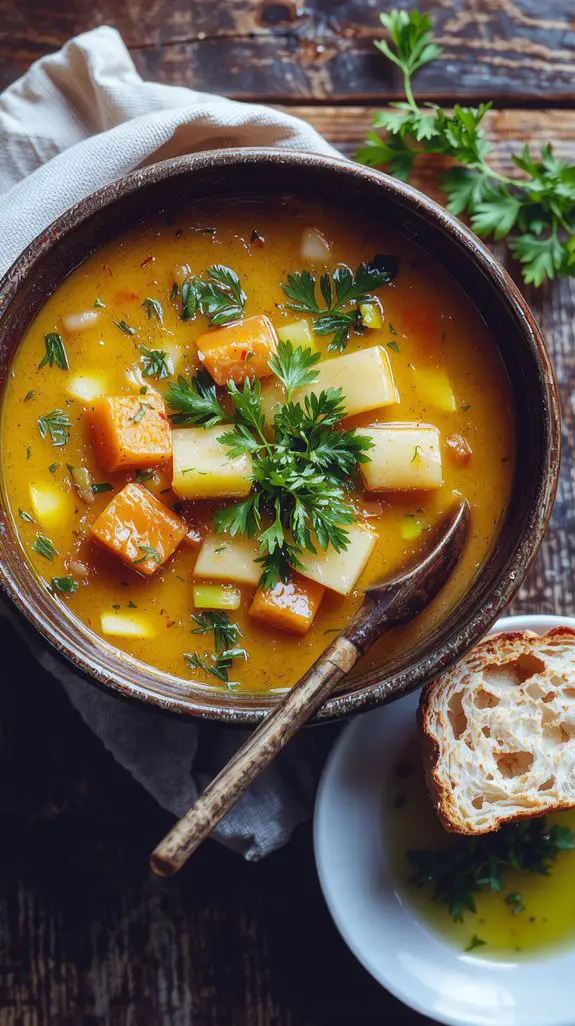Recipe
There’s something magical about a pot of homemade vegetable soup simmering on the stove—it’s comfort in a bowl, packed with fresh flavors and wholesome goodness. This recipe is my go-to for chilly nights, lazy Sundays, or anytime I need a nourishing meal that feels like a hug.
What makes it special? A rich, savory broth built from scratch, loaded with vibrant veggies that stay perfectly tender-crisp. The secret? A splash of apple cider vinegar to brighten everything up and a dash of smoked paprika for depth.
One spoonful and you’ll taste the difference—earthy, slightly sweet, and totally satisfying. Trust me, once you try this, you’ll never go back to store-bought again.
And the best part? It’s so easy, anyone can make it. Let’s get cooking!
Ingredients
This homemade vegetable soup is a celebration of fresh, hearty ingredients that come together to create a comforting and nourishing meal. The key is to balance the flavors and textures, so each bite is satisfying. Here’s what you’ll need, along with some insider tips to make it shine:
Base Ingredients:
- Olive oil: A good-quality olive oil forms the foundation for sautéing the aromatics, adding depth and richness. (Pro tip: Warm it gently before adding veggies to enhance the flavor.)
- Onion, carrots, and celery: This classic trio, known as mirepoix, is essential for building the soup’s savory base. Dice them evenly for consistent cooking.
- Garlic: Fresh garlic is non-negotiable—its aromatic punch elevates the entire dish.
Vegetables:
- Potatoes: Yukon gold or russet potatoes add heartiness and help thicken the soup naturally.
- Tomatoes: Canned diced tomatoes or fresh ripe tomatoes (when in season) bring a tangy sweetness. (Substitution: Use tomato paste for a richer flavor if fresh or canned aren’t available.)
- Green beans, zucchini, or peas: These add vibrant color and texture. Feel free to swap in any seasonal veggies you have on hand.
Broth:
– Vegetable or chicken broth: Use homemade for the best flavor, or opt for a low-sodium store-bought version to control the saltiness. (Pro tip: Simmer the broth with a Parmesan rind for an umami boost if using vegetable broth.)
Herbs & Seasonings:
- Bay leaves: Their earthy aroma is subtle but essential. Don’t skip them!
- Fresh parsley or thyme: Add these towards the end for a fresh, herbal note.
- Salt and black pepper: Season in layers as you cook to build flavor.
Little Wins:
- Parmesan rind: Toss it into the soup while simmering for a rich, savory depth.
- Fresh lemon juice or zest: A squeeze at the end brightens the flavors and adds a revitalizing finish.
- Crusty bread or crackers: Serve alongside for dipping—it’s a game-changer!
This recipe is versatile, so don’t stress if you’re missing an ingredient. The beauty of vegetable soup lies in its adaptability and simplicity.
How to Make the Best Herb-Infused Vegetable Soup Recipe

Season thoughtfully – Taste the soup and adjust the seasoning with salt, pepper, and a splash of lemon juice or vinegar to brighten the flavors without overpowering the herbs.
Simmer until vegetables are tender – Let the soup cook until all vegetables are fork-tender but not mushy.
Overcooking can dull the vibrant flavors and textures.
Finish with fresh herbs – Stir in chopped parsley or basil right before serving for a burst of freshness.
This step elevates the soup’s aroma and taste.
Serve and enjoy – Ladle the soup into bowls and garnish with a drizzle of olive oil or a sprinkle of grated Parmesan, if desired.
Pair with crusty bread for a comforting meal.
Nutrition
This homemade vegetable soup is packed with nutrients from fresh vegetables. Here’s the nutritional breakdown per serving:
| Nutrient | Amount per Serving |
|---|---|
| Calories | 120 kcal |
| Protein | 4 g |
| Carbohydrates | 20 g |
| Fiber | 6 g |
| Fat | 2 g |
| Sodium | 480 mg |
Chef Tips
Cooking this vegetable soup is straightforward, but I’ve got a few tricks to make it even better. Always sauté your onions, carrots, and celery first—this builds flavor. Use fresh herbs like thyme or parsley for brightness.
Don’t overcook the veggies; keep them tender-crisp. Add a splash of lemon juice or vinegar at the end for depth. Finally, let it sit for 10 minutes before serving. It’s worth it!
Frequently Asked Questions
Can I Freeze the Vegetable Soup?
I’d definitely freeze the vegetable soup because it holds up well in the freezer. I just let it cool completely, then store it in airtight containers or freezer bags for up to three months.
How Long Does the Soup Last in the Fridge?
I’d store the soup in the fridge for up to 4 days. I make sure it’s cooled completely first, then I keep it in an airtight container to maintain freshness and prevent any spoilage.
Can I Use Frozen Vegetables Instead of Fresh?
I can absolutely use frozen vegetables instead of fresh—I’ve done it many times. They’re convenient and still nutritious. I just add them directly to the soup without thawing, and they cook up perfectly.
What’s the Best Way to Reheat the Soup?
I’d reheat the soup gently on the stove over medium-low heat, stirring occasionally to prevent sticking. If I’m in a hurry, I’d use the microwave, heating it in short intervals and stirring in between.
Is This Soup Suitable for a Keto Diet?
I can’t say it’s keto-friendly unless it’s made with low-carb veggies like zucchini, cauliflower, and spinach, and avoids starchy ones like potatoes and carrots. You’d also need to skip high-carb add-ins like beans or pasta.










